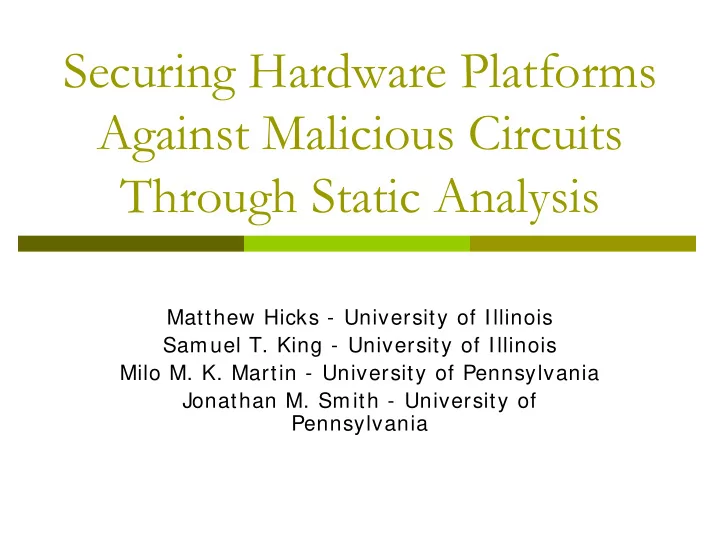

Securing Hardware Platforms Against Malicious Circuits Through Static Analysis Matthew Hicks - University of Illinois Samuel T. King - University of Illinois Milo M. K. Martin - University of Pennsylvania Jonathan M. Smith - University of Pennsylvania
Building Secure Systems � We make assumptions when designing secure systems � Break secure system, break assumptions � E.g., look for crypto keys in memory � People assume hardware is correct � What can we do if we can’t make this assumption?
Why Hardware? � Key hardware properties � Complex � Expensive � Static � Base of the system
The Threat
Dead Circuit Identification (DCI) � Goal: Help designers by highlighting all potentially malicious circuits automatically
Dead Circuit Identification (DCI) � Goal: Help designers by highlighting all potentially malicious circuits automatically � Intuition: Attacker is motivated to avoid impacting functionality during testing � Otherwise they would be caught
Dead Circuit Identification (DCI) � Goal: Help designers by highlighting all potentially malicious circuits automatically � Intuition: Attacker is motivated to avoid impacting functionality during testing � Otherwise they would be caught � Detect all circuits where the output value is identical to the input value for all tests � Internal circuits don’t impact functionality
Simple Example
Simple Example
Simple Example
What the numbers say... so far
Questions
It Can Happen IF ( r.d.inst ( conv_integer ( r.d.set ) ) = X"80082000" ) THEN hackStateM1 < = '1'; ELSE hackStateM1 < = '0'; END IF; IF ( r.d.inst ( conv_integer ( r.d.set ) ) = X"80102000" ) THEN r.w.s.s < = hackStateM1 OR rin.w.s.s; ELSE r.w.s.s < = rin.w.s.s; END IF;
Won’t there be a lot of pairs � Number of pairs is N 2 in the levels of logic
Will I have to re-run my tests � Dataflow pairs analysis is additive � New tests can be added and tested independently of old tests
What’s the relationship between pairs remaining and code coverage � Each uncovered branch is a missed opportunity for a unique assignment to a wire
Complex Example k < = good when (C1 = ‘0’) else bad; process(clk)begin l < = good when (C2 = ‘0’) else bad; if(rising_edge(clk))then out < = m when (C1 = ‘0’) else n; m < = k; n < = l; end if; end process;
Complex Example Pairs: Test cases: (good, k, 0) C1 C2 (good, m, 1) 0 0 (good, out, 1) 0 1 (bad, k, 0) 1 0 (bad, m, 1) 0 0 (bad, out, 1) ... ... (k, m, 1) 1 0 (k, out, 1) (m, out, 0) (good, l, 0) (good, n, 1) (bad, l, 0) (bad, n, 1) (l, n, 1) (l, out, 1) (n, out, 0)
Complex Example Pairs: Test cases: (good, k, 0) C1 C2 (good, m, 1) 0 0 (good, out, 1) 0 1 (bad, k, 0) 1 0 (bad, m, 1) 0 0 (bad, out, 1) ... ... (k, m, 1) 1 0 (k, out, 1) (m, out, 0) k = good (good, l, 0) (good, n, 1) l = good (bad, l, 0) (bad, n, 1) m = NA (l, n, 1) n = NA (l, out, 1) (n, out, 0) out = NA
Complex Example Pairs: Test cases: (good, k, 0) C1 C2 (good, m, 1) 0 0 (good, out, 1) 0 1 (bad, k, 0) 1 0 (bad, m, 1) 0 0 (bad, out, 1) ... ... (k, m, 1) 1 0 (k, out, 1) (m, out, 0) k = good (good, l, 0) (good, n, 1) l = bad (bad, l, 0) (bad, n, 1) m = good (l, n, 1) n = good (l, out, 1) (n, out, 0) out = good
Complex Example Pairs: Test cases: (good, k, 0) C1 C2 (good, m, 1) 0 0 (good, out, 1) 0 1 (bad, k, 0) 1 0 (bad, m, 1) 0 0 (bad, out, 1) ... ... (k, m, 1) 1 0 (k, out, 1) (m, out, 0) k = bad (good, l, 0) (good, n, 1) l = good (bad, l, 0) (bad, n, 1) m = good (l, n, 1) n = bad (l, out, 1) (n, out, 0) out = good
Complex Example Pairs: Test cases: (good, k, 0) C1 C2 (good, m, 1) 0 0 (good, out, 1) 0 1 (bad, k, 0) 1 0 (bad, m, 1) 0 0 (bad, out, 1) ... ... (k, m, 1) 1 0 (k, out, 1) (m, out, 0) k = good (good, l, 0) (good, n, 1) l = good (bad, l, 0) (bad, n, 1) m = bad (l, n, 1) n = good (l, out, 1) (n, out, 0) out = good
Complex Example Pairs: Test cases: (good, k, 0) C1 C2 (good, m, 1) 0 0 (good, out, 1) 0 1 (bad, k, 0) 1 0 (bad, m, 1) 0 0 (bad, out, 1) ... ... (k, m, 1) 1 0 (k, out, 1) (m, out, 0) (good, l, 0) (good, n, 1) (bad, l, 0) (bad, n, 1) (l, n, 1) (l, out, 1) (n, out, 0)
Problems � Undefined state � Low visibility test cases � Control information � Implementation dependent
Hardware Attack Properties � Small � Avoids visual, and side-channel analysis � Powerful � Can contaminate the entire system � Difficult to stop � Ingrained deep within the system, potentially impacting common functionality
What Happens?
Recommend
More recommend